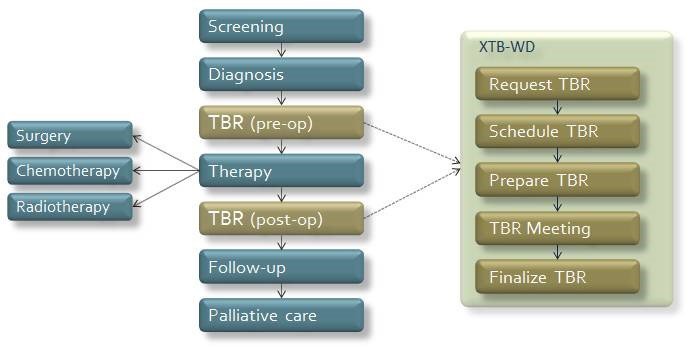Cross-enterprise Tumor Board Workflow Definition
Screening, diagnosis, treatment and aftercare of oncological patients require cooperation of a multidisciplinary team of healthcare professionals. Typically, an oncological care pathway is both multidisciplinary and often cross-enterprise, including participants from different specialisms and different hospitals. In order to be able to work together and study the different patient cases, the participating specialists, radiologists, pathologists, nurses and paramedics must have access to the relevant medical information. They also need an overview of the current status of the process to see whether the required information is available.
XTB-WD profile defines an XDW based workflow aimed to manage the creation and the execution of a tumor board.
Summary
The Cross-enterprise Tumor Board Workflow Definition (XTB-WD) describes the different Tasks of a Tumor Board Review process, and the accompanying information in the form of input- and output documents that are linked to the different Tasks in the process. The XTB-WD describes a relatively small part of a larger workflow definition, in this case an oncological care pathway. Other parts of the oncological pathway can be defined in a later stage, in other Workflow Definitions. The different Workflow Definitions can be seen as ‘building blocks’ that describe the actual care pathway of an individual patient. Below is a schematic overview of the place of the XTB Workflow Definition (XTB-WD) in an oncological pathway:
During a care episode, different Workflow Definition documents describe the actual steps of the care pathway. The unpredictability of the different steps or tasks in a care episode requires a flexible method that allows the total process to be divided into smaller Workflow Definitions. The XTB-Workflow Definition is one of those building blocks. By linking different WD documents, the relation between the different XDW documents can be created. For the correct management of a Tumor Board Review, each of the participants of the Tumor Board must have the possibility to share all relevant medical information. Currently, this is not possible, as there are no standardized means of monitoring and managing the different stages of the workflow, or of the documents that are created and attached in these different Tasks. The key elements for improvement of the current processes are:
- Managing the TBR workflow
- Tracking the relevant events and related documents
- Tracking the status of each subtask in the workflow
- Access to all relevant images, reports and other documents created in (or used in) the process
- Linking the created documents to the different Tasks in the process, thereby defining the context of these documents.
Benefits
<If the profile can improve Cost, Safety, Quality or Efficiency then list the specific examples of that benefit (e.g. error reduction, increased throughput) and how they come about (e.g. SWF reduces patient errors due to mistyped demographics at the modality by transfering demographics electronically from the Order Filler). Consider using a bullet list for readability. Such benefits help users and vendors make the business case for the profile. If the profile does not improve any aspect of Cost, Safety, Quality or Efficiency feel free to talk about something else here.>
Details
<A few paragraphs, if appropriate, providing more details (mostly in user-speak, not tech-speak) on what the profile does and how it works.>
<If the user might be familiar with the mechanisms used by the profile, you can mention them here. E.g. Evidence Documents is based on DICOM Structured Report (SR) Templates.>
<If the user might have an appreciation for the problems addressed in the profile, you can mention them here, but keep it short. E.g. Mapping HL7 Order fields to DICOM Modality Worklist attributes can be inconsistent in the marketplace, so Scheduled Workflow provides vendors with more detailed instructions.>
Systems Affected
<List (in user terms) the types of systems they might expect to have implemented actors from this profile, e.g. RIS, PACS, HIS, CAD Workstation, etc. and for each, how it would participate.>
Actors & Transactions:
<Insert an actor-transaction diagram, and or list of Content Definitions>
Specification
Profile Status: Final Text <Replace "Final Text" with "Trial Implementation" or "Public Comment" as appropriate.>
Documents:
<Provide direct links to the specific volumes or supplements, and list the volume sections relevant to this profile. This is a simple inventory of official normative and informative text. If you would like to provide a reading guide or walkthrough of what is in each of the different sections for implementers or users, do that in the Profile FAQ or the Profile Implementation Page linked below. If the profile uses transactions from multiple Tech. Frameworks, repeat the structure below.>
Underlying Standards:
<list all the standards on which the profile is based; if possible with links to sources>
See Also
<The following sections can be left out if there is nothing to point to. This is just to show where such information can go.>
Related Profiles
<List profiles this one depends on, profiles that depend on this one, profiles that are synergistic with this one. Start with the name of the other profile as a link and then explain the relationship.>
Consumer Information
The Profile FAQ Template answers typical questions about what the Profile does. <Replace the link with a link to the actual FAQ page for the Profile>
The Profile Purchasing Template describes considerations when purchasing equipment to deploy this Profile. <Replace the link with a link to the actual Purchasing page for the Profile>
Implementer Information
The Profile Implementation Template provides additional information about implementing this Profile in software. <Replace the link with a link to the actual Implementation page for the Profile>
Reference Articles
<List References (good and bad) (with link if possible) to Journal Articles that mention IHE's work (and hopefully include some analysis). Go ahead, Google: IHE <Profile Name> abstract or Google: IHE <Profile Name> and under the "more" select "Scholar". You might be surprised. >
This page is based on the Profile Overview Template
